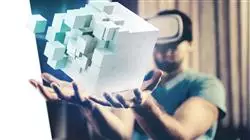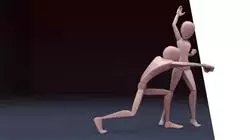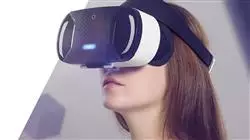University certificate
The world's largest faculty of video games”
Introduction to the Program
Virtual reality is already the present of today's entertainment and the tomorrow of many other fields. Be ahead of the rest and enroll in this Professional master’s degree to become a true expert in virtual reality video games"

Virtual reality is the dream of many artists and engineers to create an immersive experience, where the viewer can see and even feel virtual environments in a completely realistic way. Thanks to today's technological advances, this dream is possible and virtual reality is more in fashion than ever, even with applications in the fields of education and science.
Therefore, the virtual reality market is in full expansion, requiring more and more professionals with specific qualifications in this field. The ideal candidate for any position related to virtual reality, especially if it involves video games, should have skills in computer graphics and 3D modeling, as well as knowledge of the main graphics engines such as Unreal Engine or Unity 3D.
For this reason, TECH's Professional master’s degree in 3D Animation and Virtual Reality contains everything expected and required of professionals who want to specialize their career towards the creation and virtualization of realistic or fantasy environments. Thanks to this program, students will learn how to create 3D models, how to animate them and how to take them to virtual reality, as well as a variety of other fields of knowledge that will help them to be an indispensable professional for every VR graphic studio.
A program that, in addition, allows students to be flexibile without fixed schedules or compulsory attendance at physical centers, as its teaching is 100% online. This way, students will have the freedom to distribute the educational content according to their own personal constraints, because all the material can be downloaded from any device with internet access.
Valve, Microsoft or Ubisoft are some of the companies that are investing the most in virtual reality. Join their most ambitious projects with this 100% online program”
This Professional master’s degree in 3D Animation and Virtual Reality contains the most complete and up-to-date program on the market. Its most notable features are:
- The development of practical cases presented by Virtual Reality experts
- The graphic, schematic, and practical contents with which they are created, provide practical information on the disciplines that are essential for professional practice
- Practical exercises where self-assessment can be used to improve learning
- Special emphasis on 3D modeling and animation in virtual environments
- Theoretical lessons, questions to the expert, debate forums on controversial topics, and individual reflection assignments
- Content that is accessible from any fixed or portable device with an Internet connection
Virtual reality is the future of 3D animation and video games. Don’t get left behind and enroll now in this Professional master’s degree to learn about the latest advances in the sector”
The program’s teaching staff includes professionals from sector who contribute their work experience to this educational program, as well as renowned specialists from leading societies and prestigious universities.
Theultimerdia content, developed with the latest educational technology, will provide the professional with situated and contextual learning, i.e., a simulated environment that will provide immersive education programmed to learn in real situations.
This program is designed around Problem-Based Learning, whereby the professional must try to solve the different professional practice situations that arise during the academic year. For this purpose, the student will be assisted by an innovative interactive video system created by renowned and experienced experts.
Thousands of players and streamers have competed in Beat Saber. Can you imagine being the designer of the next virtual reality bestseller? With this Professional master’s degree, you can"

If you want to create experiences that will live on in the players’ memories, this Professional master’s degree will give you the tools to do just that"
Syllabus
This Professional master’s degree is structured into 10 content modules covering all fields related to 3D animation and computing in virtual reality environments, with topics and subtopics dedicated to the main tools, working methods, digital resources and forms of team organization. With all this, students will obtain a complete understanding of what is involved in the creation and subsequent implementation of virtual reality projects adapted to video games, through a 100% online program.

Conducted by experts in the field, this syllabus guarantees you will learn everything about 3D animation in virtual reality environments”
Module 1. The 3D Industry
1.1. 3D Animation and Video Game Industry
1.1.1. 3D Animation
1.1.2. 3D Animation and Video Game Industry
1.1.3. 3D Animation Future
1.2. 3D in Video Games
1.2.1. Video Games Limitations
1.2.2. 3D Video Game Development Difficulties
1.2.3. Solutions to Video Game Development Difficulties
1.3. 3D Software for Video Games
1.3.1. Maya. Pros and Cons
1.3.2. 3Ds Max. Pros and Cons
1.3.3. Blender. Pros and Cons
1.4. Pipeline in 3D Asset Generation for Video Games
1.4.1. Idea and assembly from a Model Sheet
1.4.2. Modeling with Low Geometry and High Detailing
1.4.3. Projection of Textured Details
1.5. Key Artistic 3D Styles for Video Games
1.5.1. Cartoon Style
1.5.2. Realistic Style
1.5.3. Cel Shading
1.5.4. Motion Capture
1.6. 3D Integration
1.6.1. 3D Digital World Integration
1.6.2. 3D Digital World Integration
1.6.3. Real-World Integration (AR, MR/XR)
1.7. Key 3D Factors for Different Industries
1.7.1. 3D in Film and Series
1.7.2. 3D in Video Games
1.7.3. 3D in Marketing
1.8. Render: Real-Time Rendering and Pre-Rendering
1.8.1. Lighting
1.8.2. Shadow Definition
1.8.3. Quality vs Speed
1.9. 3D Asset Generation in 3D Max
1.9.1. 3D Max Software
1.9.2. Interface, Menus, Toolbars
1.9.3. Controls
1.9.4. Scene
1.9.5. Viewports
1.9.6. Basic Shapes
1.9.7. Object Generation, Modification and Transformation
1.9.8. 3D Scene Creation
1.9.9. 3D Professional Asset Modeling for Video Games
1.9.10. Material Editors
1.9.10.1. Creating and Editing Materials
1.9.10.2. Applying Light to Materials
1.9.10.3. UVW Map Modifier. Mapping Coordinates
1.9.10.4. Texture Creation
1.10. Workspace Organization and Best Practices
1.10.1. Creation of a Project
1.10.2. Folder Structure
1.10.3. Custom Functionality
Module 2. Art and 3D in the Video Game Industry
2.1. 3D VR Projects
2.1.1. 3D Mesh Creation Software
2.1.2. Image Editing Software
2.1.3. Virtual reality
2.2. Typical Problems, Solutions and Project Needs
2.2.1. Project Needs
2.2.2. Possible Problems
2.2.3. Solutions
2.3. Esthetic Line Study for the Artistic Style Generation in Video Games: From Game Design to 3D Art Generation
2.3.1. Choice of Video Game Recipient. Who Do We Want to Reach?
2.3.2. Developer's Artistic Possibilities
2.3.3. Final Definition of the Aesthetic Line
2.4. Aesthetic Benchmarking and Competitor Analysis
2.4.1. Pinterest and Similar Sites
2.4.2. Creation of a Model Sheet
2.4.3. Competitor Search
2.5. Bible Creation and Briefing
2.5.1. Bible Creation
2.5.2. Bible Development
2.5.3. Briefing Development
2.6. Scenarios and Assets
2.6.1. Production Asset Planning at Production Levels
2.6.2. Scenario Design
2.6.3. Asset Design
2.7. Asset Integration in Levels and Tests
2.7.1. Integration Process at All Levels
2.7.2. Texture
2.7.3. Final Touches
2.8. Characters
2.8.1. Character Production Planning
2.8.2. Character Design
2.8.3. Character Asset Design
2.9. Character Integration in Scenarios and Tests
2.9.1. Character Integration Process in Levels
2.9.2. Project Needs
2.9.3. Animations
2.10. 3D Video Game Audio
2.10.1. Project Dossier Interpretation for Sound Identity Generation of Video Games
2.10.2. Composition and Production Processes
2.10.3. Soundtrack Design
2.10.4. Sound Effect Design
2.10.5. Voice Design
Module 3. Advanced 3D
3.1. Advanced 3D Modeling Techniques
3.1.1. Interface Configuration
3.1.2. Modeling Observation
3.1.3. Modeling in High
3.1.4. Organic Modeling for Videogames
3.1.5. Advanced 3D Object Mapping
3.2. Advanced 3D Texturing
3.2.1. Substance Painter Interfaces
3.2.2. Materials, Alphas and Brush Use
3.2.3. Particle Use
3.3. 3D Software and Unreal Engine Export
3.3.1. Unreal Engine Integration in Designs
3.3.2. 3D Model Integration
3.3.3. Unreal Engine Texture Application
3.4. Digital Sculpting
3.4.1. DigitalSculpting with ZBrush
3.4.2. First Steps in ZBrush
3.4.3. Interface, Menus and Navigation
3.4.4. Reference Images
3.4.5. Full 3D Modeling of Objects in ZBrush
3.4.6. Base Mesh Use
3.4.7. Part Modeling
3.4.8. 3D Model Export in ZBrush
3.5. Polypaint Use
3.5.1. Advanced Brushes
3.5.2. Texture.
3.5.3. Default Materials
3.6. Retopology
3.6.1. Rheopology Use in the Video Game Industry
3.6.2. Low-Poly Mesh Creation
3.6.3. Software Use for Rhetopology
3.7. 3D Model Positions
3.7.1. Reference Image Viewers
3.7.2. Transpose Use
3.7.3. Transpose Use for Models Composed of Different Pieces
3.8. 3D Model Export
3.8.1. 3D Model Export
3.8.2. Texture Generation for Exportation
3.8.3. 3D Model Configuration with the Different Materials and Textures
3.8.4. Preview of the 3D Model
3.9. Advanced Working Techniques
3.9.1. 3D Modeling Workflow
3.9.2. 3D Modeling Work Process Organization
3.9.3. Production Effort Estimates
3.10. Model Finalization and Export for Other Programs
3.10.1. Workflow for Model Finalization
3.10.2. ZPlugin Exportation
3.10.3. Possible Files. Advantages and Disadvantages
Module 4. 3D Animation
4.1. Software Operation
4.1.1. Information Management and Work Methodology
4.1.2. Animation
4.1.3. Timing and Weight
4.1.4. Animation With Basic Objects
4.1.5. Direct and Inverse Cinematics
4.1.6. Inverse Kinematics
4.1.7. Kinematic Chain
4.2. Anatomy. Biped Vs. Quadruped
4.2.1. Biped
4.2.2. Quadruped
4.2.3. Walking Cycle
4.2.4. Running Cycle
4.3. Facial Rig and Morpher
4.3.1. Facial Language. Lip-Sync, Eyes and Focal Points
4.3.2. Sequence Editing
4.3.3. Phonetics. Importance
4.4. Applied Animation
4.4.1. 3D Animation for Film and Television
4.4.2. Animation for Video Games
4.4.3. Animation for Other Applications
4.5. Motion Capture with Kinect
4.5.1. Motion Capture for Animation
4.5.2. Sequence of Movements
4.5.3. Blender Integration
4.6. Skeleton, Skinning and Setup
4.6.1. Interaction Between Skeleton and Geometry
4.6.2. Mesh Interpolation
4.6.3. Animation Weights
4.7. Acting
4.7.1. Body Language
4.7.2. Poses
4.7.3. Sequence Editing
4.8. Cameras and Plans
4.8.1. The Camera and the Environment
4.8.2. Composition of the Shot and the Characters
4.8.3. Finishes
4.9. Visual Special Effects
4.9.1. Visual Effects and Animation
4.9.2. Types of Optical Effects
4.9.3. 3D VFX L
4.10. The Animator as an Actor
4.10.1. Expressions
4.10.2. Actors' References
4.10.3. From Camera to Program
Module 5. Unity 3D and Artificial Intelligence proficiency
5.1. Video Games 3D Unity
5.1.1. Video Games
5.1.2. Video Games. Hits and Misses
5.1.3. Video Game Applications in Other Areas and Industries
5.2. Video Game Development. 3D Unity
5.2.1. Production Plan and Development Phases
5.2.2. Development Methodology
5.2.3. Patches and Additional Content
5.3. 3D Unity
5.3.1. Unity 3D. Applications
5.3.2. Scripting in Unity 3D
5.3.3. Asset Store and Third-Partyplugins
5.4. Physics, Inputs
5.4.1. Input System
5.4.2. Physics in Unity 3D
5.4.3. Animation and Animator
5.5. Unity Prototyping
5.5.1. Blocking and Colliders
5.5.2. Pre-Fabs
5.5.3. Scriptable Objects
5.6. Specific Programming Techniques
5.6.1. Singleton Model
5.6.2. Loading of Resources in the Execution of Windows Games
5.6.3. Performance and Profiler
5.7. Video Games for Mobile Devices
5.7.1. Games for Android Devices
5.7.2. Games for IOS Devices
5.7.3. Multiplatform Developments
5.8. Augmented Reality
5.8.1. Types of Augmented Reality games
5.8.2. ARkit and ARcore
5.8.3. Vuforia Development
5.9. Artificial Intelligence Programming
5.9.1. Artificial Intelligence Algorithms
5.9.2. Finite State Machines
5.9.3. Neural Networks
5.10. Distribution and Marketing
5.10.1. The art of Publishing and Promoting a Video Game
5.10.2. The Responsible for Success
5.10.3. Strategies
Module 6. 2D and 3D Video Game Development
6.1. Raster Graphic Resources
6.1.1. Sprites
6.1.2. Atlas
6.1.3. Texture
6.2. Interface and Menu Development
6.2.1. Unity GUI
6.2.2. Unity UI
6.2.3. UI Toolkit
6.3. Animation System
6.3.1. Animation Curves and Keys
6.3.2. Applied Animation Events
6.3.3. Modifiers
6.4. Materials and Shaders
6.4.1. Material Components
6.4.2. RenderPass Types
6.4.3. Shaders
6.5. Particles
6.5.1. Particle Systems
6.5.2. Transmitters and Sub-Transmitters
6.5.3. Scripting
6.5.4. Lighting
6.6. Lighting Modes
6.6.1. Light Baking
6.6.2. Light Probes
6.7. Mecanim
6.7.1. State Machines, SubState Machines and Transitions between Animations
6.7.2. Blend Trees
6.7.3. Animation Layers and IK
6.8. Cinematic Finish
6.8.1. Timeline
6.8.2. Post-Processing Effects
6.8.3. Universal Render Pipeline and High-Definition Render Pipeline
6.9. Advanced VFX
6.9.1. VFX Graph
6.9.2. Shader Graph
6.9.3. Pipeline Tools
6.10. Audio Components
6.10.1. Audio Source and Audio Listener
6.10.2. Audio Mixer
6.10.3. Audio Spatializer
Module 7. Programming, Mechanics Generation and Video Game Prototyping Techniques
7.1. Technical Process
7.1.1. Low-Poly and High-Poly Models in Unity
7.1.2. Material Settings
7.1.3. High-Definition Render Pipeline
7.2. Character Design
7.2.1. Movement
7.2.2. Collider Design
7.2.3. Creation and Behavior
7.3. Importing Skeletal Meshes into Unity
7.3.1. Exporting Skeletal Meshes from 3D Software
7.3.2. Skeletal Meshes in Unity
7.3.3. Anchor Points for Accessories
7.4. Importing Animations
7.4.1. Animation Preparation
7.4.2. Importing Animations
7.4.3. Animator and Transitions
7.5. Animation Editor
7.5.1. Blend Spaces Creation
7.5.2. Animation Montage Creation
7.5.3. Editing Read-Only Animations
7.6. Ragdoll Creation and Simulation
7.6.1. Ragdoll Configuration
7.6.2. Ragdoll to Animation Graphics
7.6.3. Ragdoll Simulation
7.7. Resources for Character Creation
7.7.1. Libraries
7.7.2. Importing and Exporting Library Materials
7.7.3. Handling of Materials
7.8. Work Teams
7.8.1. Hierarchy and Work Roles
7.8.2. Version Control Systems
7.8.3. Conflict Resolution
7.9. Requirements for Successful Development
7.9.1. Production for Success
7.9.2. Optimal Development
7.9.3. Essential Requirements
7.10. Publication Packaging
7.10.1. Player Settings
7.10.2. Build
7.10.3. Installer Creation
Module 8. VR Immersive Game Development
8.1. Uniqueness of VR
8.1.1. Traditional Video Games and VR. Differences
8.1.2. Motion Sickness: Smoothness vs. Effects
8.1.3. Unique VR Interactions
8.2. Interaction
8.2.1. Events
8.2.2. Physical Triggers
8.2.3. Virtual World vs. Real World
8.3. Immersive Locomotion
8.3.1. Teletransportation
8.3.2. Arm Swinging
8.3.3. Forward Movement With and Without Facing
8.4. VR Physics
8.4.1. Grabbable and Throwable Objects
8.4.2. Weight and Mass in VR
8.4.3. Gravity in VR
8.5. UI in VR
8.5.1. Positioning and Curvature of UI Elements
8.5.2. VR Menu Interaction Modes
8.5.3. Best Practices for Comfortable Experiences
8.6. VR Animation
8.6.1. Animated Model Integration in VR
8.6.2. Animated Objects and Characters vs. Physical Objects
8.6.3. Animated vs. Procedural Transitions
8.7. Avatars
8.7.1. Avatar Representation from Your Own Eyes
8.7.2. External Representation of Avatars
8.7.3. Inverse Cinematic and Procedural Avatar Animation
8.8. Audio
8.8.1. Configuring Audio Sources and Audio Listeners for VR
8.8.2. Effects Available for More Immersive Experiences
8.8.3. Audio Spatializer VR
8.9. VR and AR Project Optimization
8.9.1. Occlusion Culling
8.9.2. Static Batching
8.9.3. Quality Settings and Render Pass Types
8.10. Practice: VR Escape Room
8.10.1. Experience Design
8.10.2. Scenario Layout
8.10.3. Mechanic Development
Module 9. Professional Audio for 3D VR Video Games
9.1. Professional 3D Video Games Audio
9.1.1. Video Game Audio
9.1.2. Audio Style Types in Current Video Games
9.1.3. Spatial Audio Models
9.2. Preliminary Material Study
9.2.1. Game Design Documentation Study
9.2.2. Level Design Documentation Study
9.2.3. Complexity and Typology Evaluation to Create Audio Projects
9.3. Sound Reference Studio
9.3.1. Main References List by Similarity with the Project
9.3.2. Auditory References from Other Media to Give Video Games' Identity
9.3.3. Reference Study and Drawing of Conclusions
9.4. Sound Identity Design for Video Games
9.4.1. Main Factors Influencing the Project
9.4.2. Relevant Aspects in Audio Composition: Instrumentation, Tempo, etc
9.4.3. Voice Definition
9.5. Soundtrack Creation
9.5.1. Environment and Audio Lists
9.5.2. Definition of Motif, Themes and Instrumentation
9.5.3. Composition and Audio Testing of Functional Prototypes
9.6. Sound Effect Creation (FX)
9.6.1. Sound Effects: FX Types and Complete Lists According to Project Needs
9.6.2. Definition of Motif, Themes and Creation
9.6.3. Sound FX Evaluation and Functional Prototype Testing
9.7. Voice Creation
9.7.1. Voice Types and Phrase Listing
9.7.2. Search and Evaluation of Voice Actors and Actresses
9.7.3. Recording Evaluation and Testing of Voices on Functional Prototypes
9.8. Audio Quality Evaluation
9.8.1. Elaboration of Listening Sessions with the Development Team
9.8.2. All Audio Integration into Working Prototypes
9.8.3. Testing and Evaluation of the Results Obtained
9.9. Project Exporting, Formatting and Importing Audio
9.9.1. Video Game Audio Formats and Compression
9.9.2. Exporting Audio
9.9.3. Importing Project Audio
9.10. Preparing Audio Libraries for Marketing
9.10.1. Versatile Sound Library Design for Video Game Professionals
9.10.2. Audio Selection by Type: Soundtrack, FX and Voices
9.10.3. Audio Asset Library Marketing
Module 10. Video Game Production and Financing
10.1. Video Game Production
10.1.1. Cascading Methodologies
10.1.2. Case Studies on Lack of Project Management and Work Plan
10.1.3. Consequences of the Lack of a Production Department in the Video Game Industry
10.2. Development Teams
10.2.1. Key Departments in Project Development
10.2.2. Key Profiles in Micro-Management: Lead and Senior
10.2.3. Problems of Lack of Experience in Junior Profiles
10.2.4. Establishment of Training Plan for Low-Experience Profiles
10.3. Agile Methodologies in Video Game Development
10.3.1. Scrum
10.3.2. AGILE
10.3.3. Hybrid Methodologies
10.4. Effort, Time and Cost Estimates
10.4.1. Video Game Development Costs: Main Expense Concepts
10.4.2. Task Scheduling: Critical Points, Keys and Aspects to Consider
10.4.3. Estimates based on effort points vs Calculation in hours
10.5. Prototype Planning Prioritization
10.5.1. General Project Objective Establishment
10.5.2. Prioritization of Key Functionalities and Contents: Order and Needs by Department
10.5.3. Grouping of Functionalities and Contents in Production to Constitute Deliverables (Functional Prototypes)
10.6. Best Practices in Video Game Production
10.6.1. Meetings, Dailies, Weekly Meetings, End of Sprint Meetings, and ALPHA, BETA and RELEASE Milestone Review Meetings
10.6.2. Sprint Speed Measurement
10.6.3. Lack of Motivation and Low Productivity Detection and Anticipation of Potential Production Problems
10.7. Production Analysis
10.7.1. Preliminary Analysis 1: Market Status Review
10.7.2. Preliminary Analysis 2: Establishment of Main Project References (Direct Competitors)
10.7.3. Previous Analyses Conclusions
10.8. Development Cost Calculation
10.8.1. Human resources
10.8.2. Technology and Licensing
10.8.3. External Development Expenses
10.9. Investment Search
10.9.1. Types of Investors
10.9.2. Executive Summary
10.9.3. Pitch Deck
10.9.4. Publishers
10.9.5. Self-Financing
10.10. Project Post-Mortem Elaboration
10.10.1. Post-Mortem Elaboration Process in the Company
10.10.2. Positive Aspect Analysis of the Project
10.10.3. Negative Aspect Analysis of the Project
10.10.4. Improvement Proposal on the Project’s Negative Points and Conclusions

A unique, key and decisive training experience to boost your professional development"
If you are passionate about video games and 3D animation, this Professional Master's Degree is for you. Learn how to create immersive virtual worlds and stunning 3D characters with the latest tools and techniques used in the video game industry. Discover how to apply virtual reality to take the gaming experience to the next level. Delivered online, this Professional Master's Degree will allow you to develop advanced skills and knowledge in 3D animation and virtual reality. Enroll now and become a highly skilled professional in the field of video games and virtual reality!







